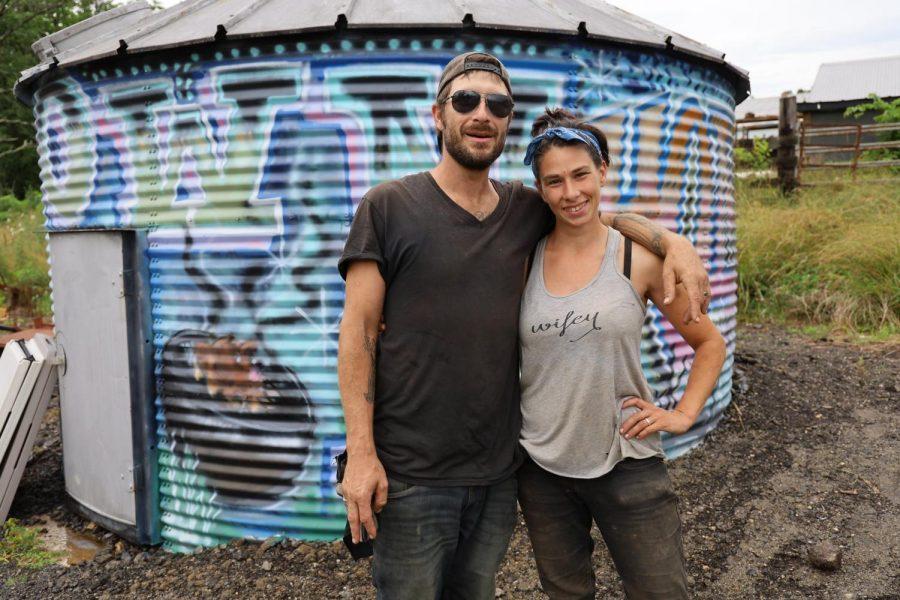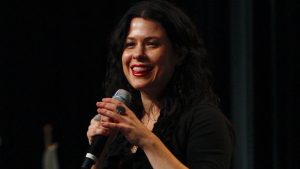Putting down roots: Jewish couple finds their calling on DeSoto farm
Published September 6, 2019
A menorah sits on a shelf in Dave Blum and Autumn Sij’s farmhouse kitchen. The ketubah commemorating their wedding vows hangs on the wall. And outside roaming in a pasture are 65 pigs.
Blum and Sij are Jewish, and they’re pig farmers.
They also raise an impressive array of produce — 170 varieties of heirloom vegetables, including 19 of tomatoes and 13 of peppers — at Such and Such Farm in De Soto, 50 miles south of St. Louis. As I arrived at the farm, a goat greeted me and bleated.
Two large sows grunted.
I mentioned to Blum that I’d read of an Israeli pig farmer who fashioned a device to capture the animal’s droppings so they didn’t fall on sacred soil of the holy state. Blum raised an eyebrow.
“Yeah, we don’t do that,” he said.
Although he probably could. Blum is resourceful, a problem solver. He’s also an expert welder and can fix most any mechanical device. He doesn’t mind getting dirty and tromping around in muck.
Such and Such Farm is dotted with colorful murals on barns and sheds, reflecting Blum’s fondness for graffiti and street art.
Before they began farming eight years ago, Blum, 36, and Sij, 31, lived in a graffiti-covered loft on Washington Avenue in downtown St. Louis. It was an easy walk to work for Blum, who was a key member of the crew that restored the International Shoe Warehouse to become the City Museum.
Blum grew up in University City and celebrated his bar mitzvah at United Hebrew Congregation. As a child, he never considered farming as a potential life goal. His interest ran more to hip-hop and skateboarding. He’s the oldest of three brothers.
Alex, the youngest Blum, is an executive in the mortgage finance business. Ethan, the middle brother, is a filmmaker.
Their father, Don, is a retired doctor, and their mother, Marilyn, worked as a teacher and volunteered for several nonprofits.
Dave Blum graduated from Crossroads High School, then went to college at Pratt Institute to learn industrial design. Blum loves building and restoring, so he headed to France and took a job working on old masonry. Returning home to St. Louis, he showed up at the then-under construction City Museum and asked the late Bob Cassilly for a job.
“It was the most formative job I ever had,” Blum said, explaining Cassilly’s unusual interview process, like looking at a prospect’s hands. If the worker had soft hands without callouses, Cassilly was likely to say, “Sorry, we’re not hiring now.”
“I went there with a bunch of pictures of stuff I built and gave them to Mary Levi (a City Museum administrator), and she showed them to Bob,” Blum said. “He asked me to weld something and Mary approved my welds. Bob said, ‘Come back tomorrow and have boots on.’ The next thing I knew, five years had flown by.”
The farm began for Blum and Sij as homesteading. They were unhappy with the existing food delivery system and simply chose not to participate.
“There’s something really human about farming and growing your own food and raising animals,” Blum said. “It activates something in your DNA.”
What’s a nice Jewish boy doing raising hogs?
After Blum and Sij pivoted to a commercial farm five years ago, they realized they couldn’t make any money raising produce in the winter months without a giant greenhouse.
“Pigs are nice because they’re hard to kill and easy to raise,” Blum said. “They’re also harder to get hurt by. They’re not going to stampede you like cattle might. And they’re considered an easier entry-level livestock. We chose a high-dollar heritage breed, Swabian Hall.”
Obtaining breeding stock proved challenging because it’s a rare German variety. Blum did some research and found Carl Blake, a farmer in Iowa who specializes in the breed. Initially, Blake refused to sell Blum any breeding stock.
“I said, ‘C’mon, man, I’ll show you I’m serious,’ ” Blum said. “So I went up there with a friend to Carl’s farm in Iowa, and I built him a bunch of stuff and he said, ‘All right, I’ll sell you some breeding stock,’ and he’s been kind of a pig mentor ever since.”
The name of the farm began as an inside joke. Lots of farm names include an adjective and a nature noun, Blum said, like Dancing Crow Farm or Jumping Cow Farm. They went with a much less specific name. All their friends and clients thought it was clever, so they stuck with it.
Such and Such Farm marches to a decidedly different drummer. That includes the practice of naming the pigs. I met three lovely sows: Amy Swinehouse, Piggy Azalea and Hamgelina Jolie.
Blum said most pig farmers resist naming animals that are destined for the slaughterhouse. He and Sij believe in the opposite: They want to make the pigs’ lives rich and fulfilling while they wallow through open pastures, rather than being penned up.
Even a routine event like feeding the pigs turns into an adventure.
On this day, Blum and Sij loaded up a tractor with a cornucopia of fruits and vegetables — watermelon, squash, cantaloupe — all extremely fresh from the garden. Then they hauled it out to the pasture and waited for the pigs to come running. Maybe waddling is a more apt description of their gait. Blum and Sij called out to them and offered up the produce. The pigs chomped away.
On the way back down to the farmhouse, Sij called excitedly to Blum. She discovered a large cache of valuable chanterelle mushrooms.
“All right!” Blum bellows. “Let’s go make some money!”
‘Every day’s a vacation when you love your occupation’
Blum considers himself the operations guy, the mechanical and equipment expert on the farm. Sij excels with living things.
She’s especially proficient at growing heirloom vegetables.
That’s good news for chefs at more than a dozen St. Louis restaurants who seek locally grown artisanal produce.
“They’re great people and they have a really solid product,” Rick Lewis, chef at Grace Meat + Three in the Grove said of Blum and Sij. “We work together to determine what they’re going to grow for the year. Obviously, their farming practices are top-notch, which is really important to us. It even gets down to collaborative things, like what do we do with the pork fat they have?”
Swabian Hall is a fattier breed than typical grocery store pork. To eliminate waste, Sij learned to make soap from lard. Such and Such Farm, of course, grows the botanicals like lavender used as scents for the soap.
Another chef and fan of Blum and Sij is Chef Chris “Mac” McKenzie of Mac’s Local Buys Market in Dogtown.
“They’re a real joy to work with,” McKenzie said. “One of the coolest things is they’re contract farmers. They’re not just growing things to grow things. They’re growing things that we need, like cucumbers that we use to make pickles.
“We don’t have to buy them from a big corporate provider. We love working with Dave and Autumn. We use them for our produce in the restaurant, and they are the sole produce provider for our summer CSA (consumer supported agriculture) program.”
Blum doesn’t let his welding skills rust. He’ll build whatever a chef needs. Right now, he’s fabricating an outdoor cooking device for James Beard Award winner Gerald Craft for Cinder House at the Four Seasons Hotel in Laclede’s Landing.
When he’s not at the farm, Blum works with a team of friends to renovate a church in north St. Louis. Their long-range plan is to convert it to a community center to benefit an underserved neighborhood.
For Blum and Sij, the workday begins at sunrise and rarely lets up. During the busy summer growing season, Such and Such Farm has three full-time and two part-time workers.
I asked Blum if he ever thought about taking a career path like his brother Alex, with an assistant to screen his calls and a comfortable air-conditioned office. He considered the suggestion, but quickly confirmed that farm living is the life for him.
“When I take a step back and look at what I do versus working in an office, getting up in the morning, going out to the car and going to work for somebody else, and then watch TV until I fall asleep, then get up and repeat … no way,” he said. “I mean, every day’s a vacation when you love your occupation. And doing very difficult things, when you succeed at it, it’s very rewarding and satisfying.
“Better to aim high and fail than to aim low and succeed. I mean, we’re learning new things all the time. Every day is different, every day there are new things to learn, new problems to solve. It’s fun.”















